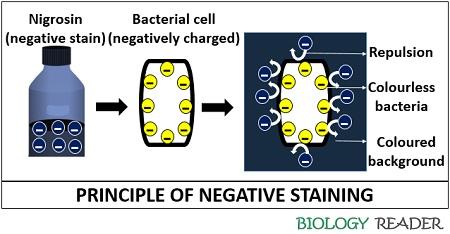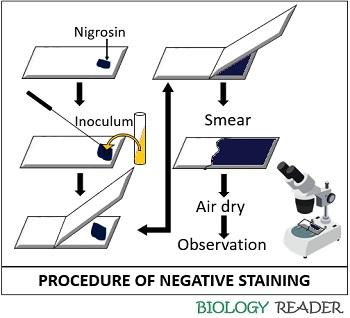Negative staining or Indirect staining refers to a staining technique that helps us visualize various microorganisms through light and electron microscopy.
In bright field microscopy, the method of indirect staining employs liquid medium (black coloured dyes) like Nigrosin and India ink that stains the background, leaving the bacteria unstained.
The negative staining technique uses a solid matrix (commonly potassium phosphotungstate) in transmission electron microscopy. To elucidate the morphology of a test organism in TEM, you need to mix the specimen in water or ammonium acetate along with the solution of phosphotungstate.
Then, apply the suspension to the carbon-coated grid either by spraying and spreading the sample. This post describes the definition, purpose, principle and procedure of negative staining by using light microscopy.
Also, the definition and examples of negative stain have been explained, along with the advantages and disadvantages of the negative staining method.
Content: Negative Staining
Negative Staining Definition
Negative staining refers to a rapid, uncomplicated and qualitative staining technique that examines bacterial morphological characteristics. It is named negative staining because it uses negative or acidic stains that do not bind to the test specimen.
We observe a clear specimen against a dark coloured background through the negative staining method. The negatively charged stain does not penetrate the negatively charged cell surface. Therefore, this technique is the opposite of simple staining that stains the specimen by leaving a colourless background).
Purpose
It determines the bacterial shape and arrangement. It also helps us to stain the organisms that are too sensitive to be heat fixed. Using this method, we can prepare slides of the different microbial samples and examine them using different microscopy techniques.
Definition of Negative Stain
It refers to the acidic dye that readily gives off H+ ion, accepts OH- ion, and possesses a negative charge. As the negative stain carries a negative charge, it is also called anionic stain or acidic stain.
The negative stain facilitates the elucidation of colourless bacteria against a coloured background. There will be repulsion between the negatively charged dye and a negatively charged bacterial cell. As a result, the specimen seems clear or transparent and outlined by the stained or dark background.
Examples of Negative Stain
- 10% Nigrosin: Dissolve 10 grams of nigrosin, 0.5 ml of formalin in 100 ml of distilled water.
- 2% Eosin: Dissolve 2 grams of eosin in 100 ml of distilled water.
- (1% aqueous) Congo red: Dissolve 10 grams of Congo red into 1000 ml of distilled water.
Principle of Negative Staining
Negative staining makes the use of negative or acidic dyes such as Nigrosin, Congo red, India ink etc. The negative stains carry a negatively charged chromophore group that readily gives up the proton ions.
As we know, the surface of the bacteria carries a negative charge, which means that the cell surface will not take up the colour of the negatively charged stain.
As a result, repulsion occurs between the negatively charged bacterial cell surface and the negatively charged stain. Therefore, the repulsion stains the background dark by leaving a bacterial cell colourless.
Negative Staining Procedure
- Take a clean, grease-free and dry glass slide.
- Put a minimal drop of nigrosin towards one end of the glass slide via a dropper.
- Then, take the inoculum from the culture plates or slant culture via a sterilized inoculating loop and mix it with a drop of nigrosin.
- After that, take another clean, grease-free and dry glass slide and place the one end of it towards the centre.
- Then, tilt the glass slide over the stain containing the test organism by making an acute angle.
- Slightly draw the tilted slide until it touches the drop of the culture organism, and drag it across the edge of the glass slide to make an even, broad and thin bacterial smear.
- Allow the glass slide to air dry (do not heat fix).
- At last, put a drop of oil immersion and observe the glass slide under the microscope for the appearance of a colourless bacterial cell with a grey background.
Advantages
- Through negative staining, clear unstained cells are easily observable against the black coloured stained background.
- A negative staining method does not involve the heat-fixing of the specimen. As a result, the cell will not deform by the heat.
- It can also stain heat-sensitive microorganisms like Spirochetes, Yeasts etc.
- The negative staining technique also permits examining a transparent capsule around the cell wall of various microorganisms like Cryptococcus neoformans.
- It is quite an easy and rapid method that makes the use of a single acidic stain only.
Disadvantages
- Negative staining does not provide much information about the cell rather than the cell size, shape and arrangement.
- By using this technique, we cannot examine a particular strain or a type of organism.
Conclusion
Therefore, we can conclude that a negative staining technique is a simple method to examine the microorganism using a single acidic stain. Negative staining results in an unstained or clear specimen with a dark coloured background.
Repulsion occurs between the negatively charged stain and the specimen, after which we could observe cells of different shapes and sizes as unstained outlines against a stained background.

